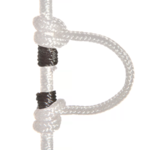I've been seeing some variations of the D-Loop installation on some bows. 
I've seen serving ties, inside the D-Loop, just a plain ole D-Loop (which is what I use) and metal D-Loops.
String pinch on the knock is why the guys use knock rings or serving ties inside the D-Loop. What difference in arrow flight that would make, I don't know. The string is in a vertical position at the release point, so there wouldn't be any string pinch on the knock. I'm not sure where this train of thought is coming from or going.
As for the metal D-Loops, I would think that the string oscillation after the release could cause some damage to the cables or other bow parts in the same area of that metal D-Loop. High speed videos will show a lot of movement on items like this, on a bow.
I guess my question is... What makes the difference and/or why would you use something other than a standard D-Loop?
I've seen serving ties, inside the D-Loop, just a plain ole D-Loop (which is what I use) and metal D-Loops.
String pinch on the knock is why the guys use knock rings or serving ties inside the D-Loop. What difference in arrow flight that would make, I don't know. The string is in a vertical position at the release point, so there wouldn't be any string pinch on the knock. I'm not sure where this train of thought is coming from or going.
As for the metal D-Loops, I would think that the string oscillation after the release could cause some damage to the cables or other bow parts in the same area of that metal D-Loop. High speed videos will show a lot of movement on items like this, on a bow.
I guess my question is... What makes the difference and/or why would you use something other than a standard D-Loop?


